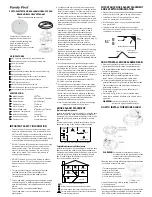
12
5
DESCRIPTION AND OPERATION
5.1.
Arrangement and Operation Principle
5.1.1.
The optic block of the detector is equipped with latches for attaching a laser alignment tool.
These latches provide enough accurately superposing of the optical axes of the alignment tool and the
detector unit. A spring-screw positioning mechanism is used in the detector unit to change the angle of
the slope of the radiation pattern by
±
5 degrees in horizontal and vertical planes.
5.1.2.
The optical system of the unit is a four-channel one. Two channels are used to form a narrow
optical beam of infrared radiation while two other channels are used for focusing received radiation.
The multichannel principle of organization of the optical system allowed: to increase the power of the
optical beam (due to two emitters), to increase the sensitivity (due to two receivers), to make the top of
the radiation pattern flatter, to reduce the influence of insects on the lens which generally result in a
positive effect on improving noise immunity and stability of the detector operation.
5.1.3.
The design of the optical system provides effective suppression of the side lobes of the
radiation pattern and is reliably protected against penetration of dust, water, and insects into it. The
lens of the optical system is made of a material that is selectively transparent to IR radiation and
practically does not transmit visible light.
5.1.4.
The remote indicator and control unit allows monitoring for conditions of the transceiver unit
by means of the built-in LED and provides simulating Test and Trouble signal by means of buttons and
remote connection of the IPDL-152 test station to the specific connector.
5.1.5.
The principle of operation of a beam detector is based on the phenomenon of reducing of the
intensity of a beam passed through a smoke-filled environment. The S2000-IPDL relates to single-
ended detectors which are known as reflected type detectors. For such detectors the optical beam
covers the monitored distance twice, so the actual attenuation of the received signal by the smoke is
significantly higher than the value of the optical density of the monitored medium, for example, for an
optical density of 1 dB (20%) the attenuation of the signal will be 2 dB (36%).
5.1.6.
To provide correct operation, the detector must be carefully adjusted during commissioning,
and a special mode is provided for this. The procedure of alignment involves superposing the radiation
pattern of the transceiver with the direction on the reflector in order to achieve the highest possible
level of the received signal for the specific conditions of use (the required range for the protected
premises).
5.1.7.
On exiting the aligning mode the received signal level is written to the non-volatile memory
(EEPROM) as a given value, remains constant until the next alignment procedure, and is used to define
upper and lower limits for compensation of creeping of the current signal. If these limits are reached
then Trouble-High or Trouble-Low condition is stated.
5.1.8.
A compensated value of received signal is also stored in the non-volatile memory and is
rewritten to this memory every half an hour of operation in the quiescent mode. The relevant DIP
switch provides selecting one of the two compensation rate values namely fast rate (to provide stable
operation under rapidly changing conditions) or slow rate (for early detection of slowly developing
fires).
5.1.9.
Comparing the current value of a received signal with the compensated one (as with the
parameter of unpolluted air) the detector determines the value of attenuation (optical density) and
makes a decision whether or not the set thresholds of Fire Alarm and Trouble-Beam signals are
exceeded. The Trouble-Beam threshold is set by manufacturer and equal to 80% signal attenuation












































